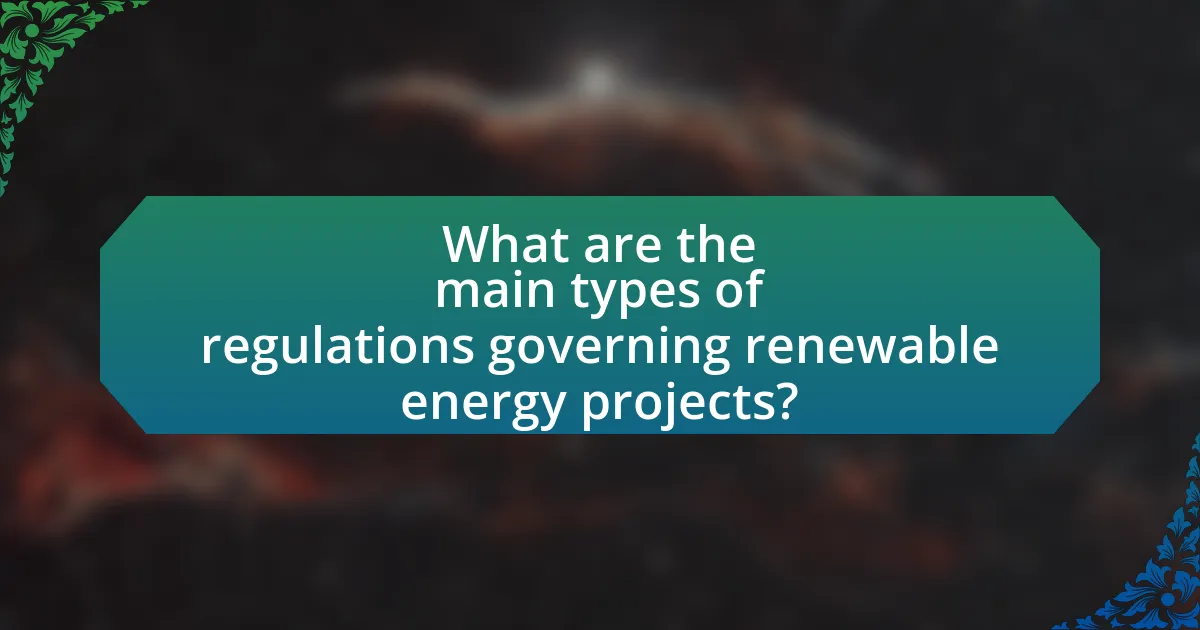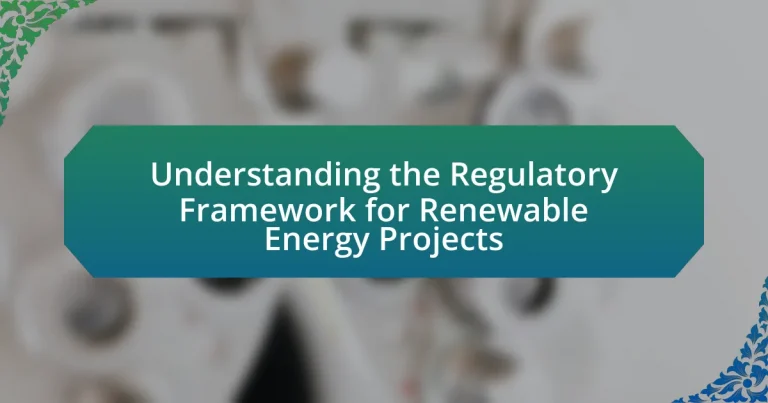The article focuses on the regulatory framework governing renewable energy projects, which encompasses laws, regulations, and policies at federal, state, and local levels. It details how these regulations impact project development, financing, and compliance, highlighting key components such as permitting processes, environmental assessments, and financial incentives. The article also examines regional variations in regulations, the role of government agencies, and the influence of international agreements on national policies. Additionally, it addresses best practices for stakeholders to navigate the regulatory landscape effectively, ensuring adherence to safety and operational standards while optimizing project outcomes.

What is the Regulatory Framework for Renewable Energy Projects?
The regulatory framework for renewable energy projects consists of laws, regulations, and policies that govern the development, operation, and integration of renewable energy sources into the energy market. This framework typically includes federal, state, and local regulations, which may encompass permitting processes, environmental assessments, grid interconnection standards, and financial incentives such as tax credits or subsidies. For instance, in the United States, the Public Utility Regulatory Policies Act (PURPA) and the Energy Policy Act provide foundational guidelines for renewable energy development, while state-level renewable portfolio standards mandate specific percentages of energy to be sourced from renewable technologies. These regulations ensure compliance with safety, environmental, and economic standards, facilitating the transition to sustainable energy systems.
How does the regulatory framework impact renewable energy development?
The regulatory framework significantly impacts renewable energy development by establishing the rules, incentives, and standards that govern the sector. These regulations can facilitate or hinder investment in renewable technologies through mechanisms such as tax credits, renewable portfolio standards, and permitting processes. For instance, the U.S. Investment Tax Credit (ITC) has been crucial in promoting solar energy development, leading to a 167% increase in solar capacity from 2016 to 2020, according to the Solar Energy Industries Association. Additionally, streamlined permitting processes can reduce project timelines and costs, thereby enhancing the feasibility of renewable energy projects. Conversely, stringent regulations or lack of clarity can create barriers, deterring investment and slowing down deployment.
What are the key components of the regulatory framework?
The key components of the regulatory framework for renewable energy projects include legislation, regulatory agencies, compliance requirements, and incentives. Legislation establishes the legal basis for renewable energy development, while regulatory agencies oversee implementation and enforcement of these laws. Compliance requirements ensure that projects meet environmental, safety, and operational standards. Incentives, such as tax credits and grants, encourage investment and development in renewable energy technologies. These components work together to create a structured environment that supports the growth and sustainability of renewable energy initiatives.
How do regulations vary by region or country?
Regulations for renewable energy projects vary significantly by region and country due to differing governmental policies, economic conditions, and environmental priorities. For instance, the European Union has stringent regulations aimed at reducing carbon emissions and promoting renewable energy sources, while the United States has a more decentralized approach, with states like California implementing aggressive renewable energy mandates, whereas others may have minimal requirements. Additionally, countries like China have aggressive targets for renewable energy deployment, supported by substantial government investment, contrasting with regions that may lack such financial backing or regulatory frameworks. These variations are influenced by local energy needs, resource availability, and political will, leading to a diverse landscape of regulatory environments across the globe.
Why is understanding the regulatory framework important for stakeholders?
Understanding the regulatory framework is crucial for stakeholders because it directly influences project feasibility, compliance, and investment decisions. Stakeholders, including developers, investors, and policymakers, must navigate various regulations that govern renewable energy projects to ensure legal compliance and optimize project outcomes. For instance, the International Renewable Energy Agency (IRENA) highlights that clear regulatory frameworks can reduce investment risks and enhance project bankability, thereby attracting more capital into the renewable energy sector.
What roles do government agencies play in the regulatory process?
Government agencies play critical roles in the regulatory process by establishing, enforcing, and overseeing regulations that govern various sectors, including renewable energy. These agencies, such as the Environmental Protection Agency (EPA) and the Federal Energy Regulatory Commission (FERC), create guidelines to ensure compliance with environmental standards and energy policies. For instance, the EPA regulates emissions and environmental impacts of renewable energy projects, while FERC oversees the transmission and sale of electricity, ensuring fair access to energy markets. Their actions are essential for maintaining safety, protecting public health, and promoting sustainable practices within the renewable energy sector.
How do regulations affect project financing and investment?
Regulations significantly influence project financing and investment by establishing the legal framework within which projects operate. These regulations can dictate the terms of funding, risk assessment, and overall project viability. For instance, stringent environmental regulations may require additional compliance costs, impacting the financial feasibility of renewable energy projects. According to a report by the International Renewable Energy Agency (IRENA), regulatory frameworks that provide clear guidelines and incentives can enhance investor confidence, leading to increased capital flow into renewable energy sectors. Conversely, ambiguous or overly restrictive regulations can deter investment, as seen in various regions where regulatory uncertainty has led to stalled projects and reduced financing opportunities.

What are the main types of regulations governing renewable energy projects?
The main types of regulations governing renewable energy projects include federal, state, and local regulations, as well as industry-specific standards. Federal regulations often encompass policies from agencies like the Federal Energy Regulatory Commission (FERC) and the Environmental Protection Agency (EPA), which set guidelines for energy production and environmental protection. State regulations vary widely and may include renewable portfolio standards (RPS), tax incentives, and interconnection rules that facilitate the integration of renewable energy into the grid. Local regulations can involve zoning laws and permitting processes that dictate where renewable energy projects can be developed. Industry-specific standards, such as those from the International Electrotechnical Commission (IEC), provide technical guidelines to ensure safety and efficiency in renewable energy technologies. These regulations collectively shape the operational landscape for renewable energy projects, ensuring compliance with legal, environmental, and technical requirements.
What are the different categories of renewable energy regulations?
The different categories of renewable energy regulations include federal regulations, state regulations, local regulations, and international agreements. Federal regulations, such as those enforced by the Federal Energy Regulatory Commission (FERC), set nationwide standards for energy production and distribution. State regulations vary widely and often include renewable portfolio standards (RPS) that mandate a certain percentage of energy to come from renewable sources. Local regulations can involve zoning laws and permitting processes that affect the installation of renewable energy systems. International agreements, like the Paris Agreement, establish commitments among countries to reduce greenhouse gas emissions and promote renewable energy adoption. These categories collectively shape the operational landscape for renewable energy projects.
How do environmental regulations influence project approval?
Environmental regulations significantly influence project approval by establishing criteria that projects must meet to minimize environmental impact. These regulations often require comprehensive assessments, such as Environmental Impact Statements (EIS), which evaluate potential effects on ecosystems, air quality, and water resources. For instance, the National Environmental Policy Act (NEPA) mandates federal agencies to consider environmental impacts before making decisions, thereby affecting the timeline and feasibility of project approvals. Compliance with these regulations can lead to delays or modifications in project design, ensuring that environmental considerations are integrated into the planning process.
What are the implications of zoning and land use regulations?
Zoning and land use regulations significantly influence the development and implementation of renewable energy projects by dictating where and how these projects can be established. These regulations can either facilitate or hinder the deployment of renewable energy infrastructure, such as wind farms and solar installations, depending on the designated land use categories and zoning restrictions in a given area. For instance, areas zoned for industrial use may allow for large-scale solar farms, while residential zones may impose limitations that restrict such developments. Additionally, zoning regulations can affect project timelines and costs, as developers must navigate local permitting processes and compliance with specific land use policies. The implications of these regulations are evident in the varying rates of renewable energy adoption across different regions, as areas with supportive zoning frameworks tend to experience faster growth in renewable energy projects compared to those with restrictive regulations.
What are the compliance requirements for renewable energy projects?
Compliance requirements for renewable energy projects typically include obtaining necessary permits, adhering to environmental regulations, and meeting safety standards. These projects must comply with federal, state, and local laws, which often involve environmental impact assessments, zoning approvals, and interconnection agreements with utility companies. For instance, the National Environmental Policy Act mandates federal agencies to assess the environmental effects of their proposed actions before making decisions, ensuring that renewable energy projects consider ecological impacts. Additionally, projects may need to comply with specific renewable energy standards set by state legislatures, such as renewable portfolio standards, which require a certain percentage of energy to come from renewable sources.
What documentation is necessary for regulatory compliance?
Documentation necessary for regulatory compliance in renewable energy projects includes permits, environmental assessments, and compliance reports. Permits are required to ensure that projects meet local, state, and federal regulations, while environmental assessments evaluate the potential impacts on ecosystems and communities. Compliance reports document adherence to regulatory requirements and are often mandated by governing bodies to ensure ongoing compliance throughout the project lifecycle. These documents are essential for demonstrating accountability and transparency in the development and operation of renewable energy projects.
How can projects ensure adherence to safety and operational standards?
Projects can ensure adherence to safety and operational standards by implementing comprehensive risk management strategies and adhering to established regulatory frameworks. These strategies include conducting thorough safety assessments, regular training for personnel, and continuous monitoring of compliance with safety regulations. For instance, the Occupational Safety and Health Administration (OSHA) provides guidelines that, when followed, significantly reduce workplace incidents. Additionally, projects can utilize industry standards such as ISO 45001 for occupational health and safety management systems, which have been shown to improve safety performance and operational efficiency.

How do international agreements influence national regulatory frameworks?
International agreements significantly shape national regulatory frameworks by establishing common standards and obligations that countries are expected to follow. For instance, agreements like the Paris Agreement compel nations to adopt specific climate targets, which in turn influence domestic laws and regulations related to renewable energy development. Countries often align their policies with international commitments to enhance credibility and attract foreign investment, as seen in the European Union’s Renewable Energy Directive, which mandates member states to implement national measures supporting renewable energy sources. This alignment ensures that national regulations not only comply with international norms but also facilitate cooperation and funding opportunities in renewable energy projects.
What role do treaties and agreements play in shaping regulations?
Treaties and agreements play a crucial role in shaping regulations by establishing binding commitments among nations that influence domestic laws and policies. For instance, international treaties like the Paris Agreement set specific targets for greenhouse gas emissions, compelling countries to create regulations that align with these commitments. This alignment often leads to the development of national frameworks that promote renewable energy projects, as countries seek to fulfill their obligations under such treaties. The effectiveness of these treaties is evidenced by the increased investment in renewable energy technologies and the adoption of supportive regulatory measures in various countries, demonstrating their significant impact on shaping regulatory landscapes.
How do international standards affect local regulatory practices?
International standards significantly influence local regulatory practices by providing a framework that enhances consistency, safety, and efficiency in regulatory processes. These standards, such as those set by the International Organization for Standardization (ISO) or the International Electrotechnical Commission (IEC), serve as benchmarks that local regulators can adopt to ensure compliance with global best practices. For instance, the adoption of ISO 14001 for environmental management systems has led many countries to align their local regulations with international expectations, thereby improving environmental performance in renewable energy projects. This alignment not only facilitates international trade and investment but also encourages local industries to innovate and improve their operational standards, ultimately leading to enhanced competitiveness in the global market.
What are the challenges of aligning national regulations with international commitments?
Aligning national regulations with international commitments presents several challenges, primarily due to differences in legal frameworks, priorities, and capacities among countries. National governments often prioritize domestic economic interests and political considerations, which can conflict with international obligations aimed at sustainability and environmental protection. For instance, the Paris Agreement requires countries to commit to reducing greenhouse gas emissions, but national policies may favor fossil fuel industries due to economic dependencies. Additionally, varying levels of regulatory capacity can hinder effective implementation; developing countries may lack the resources or expertise to meet international standards, leading to discrepancies in compliance. These challenges are further complicated by the need for stakeholder engagement and public support, which can vary significantly across different national contexts.
How can stakeholders navigate the regulatory landscape effectively?
Stakeholders can navigate the regulatory landscape effectively by staying informed about current regulations and engaging with regulatory bodies. Regularly reviewing updates from agencies such as the Federal Energy Regulatory Commission (FERC) and the Environmental Protection Agency (EPA) ensures stakeholders are aware of changes that may impact renewable energy projects. Additionally, participating in public comment periods and stakeholder meetings allows for direct communication with regulators, fostering a collaborative environment. Research indicates that proactive engagement can lead to smoother project approvals and compliance, as seen in the successful implementation of the Clean Power Plan, which involved extensive stakeholder input.
What strategies can be employed to stay updated on regulatory changes?
To stay updated on regulatory changes, individuals and organizations can employ strategies such as subscribing to industry newsletters, attending relevant conferences, and engaging with regulatory bodies. Subscribing to newsletters from organizations like the International Renewable Energy Agency (IRENA) provides timely updates on policy changes and regulatory developments. Attending conferences, such as the Renewable Energy World Conference, allows stakeholders to network and gain insights from experts about upcoming regulations. Additionally, actively engaging with regulatory bodies, such as the Federal Energy Regulatory Commission (FERC) in the United States, ensures direct access to the latest regulatory information and opportunities for public comment on proposed changes. These strategies collectively enhance awareness and understanding of the evolving regulatory landscape in renewable energy.
How can collaboration with regulatory bodies enhance project success?
Collaboration with regulatory bodies enhances project success by ensuring compliance with legal standards and facilitating smoother project approvals. Engaging with these bodies early in the project lifecycle allows for the identification of regulatory requirements, which can prevent costly delays and modifications later on. For instance, projects that align with environmental regulations from the outset are less likely to face legal challenges, as seen in the case of the Cape Wind project in Massachusetts, which benefited from early engagement with regulatory agencies to address environmental concerns. This proactive approach not only streamlines the permitting process but also fosters trust and transparency, ultimately leading to a higher likelihood of project completion and operational success.
What best practices should be followed in managing regulatory compliance?
To effectively manage regulatory compliance, organizations should implement a structured compliance management system that includes regular audits, employee training, and clear documentation processes. Regular audits help identify compliance gaps and ensure adherence to regulations, while employee training fosters a culture of compliance and keeps staff informed about relevant laws and policies. Clear documentation processes facilitate tracking compliance activities and provide evidence during inspections or audits. According to a study by the Compliance and Ethics Institute, organizations with robust compliance programs experience 50% fewer regulatory violations, underscoring the importance of these best practices in maintaining regulatory compliance.
How can project developers streamline the compliance process?
Project developers can streamline the compliance process by implementing a comprehensive regulatory management system that automates tracking and reporting requirements. This approach allows developers to efficiently manage documentation, deadlines, and communication with regulatory bodies, reducing the risk of non-compliance. For instance, utilizing software tools designed for compliance management can enhance visibility into regulatory changes and facilitate timely updates to project plans. Studies indicate that organizations employing such systems experience a 30% reduction in compliance-related delays, demonstrating the effectiveness of technology in optimizing compliance workflows.
What common pitfalls should be avoided in regulatory management?
Common pitfalls to avoid in regulatory management include inadequate stakeholder engagement, failure to stay updated on regulatory changes, and lack of comprehensive documentation. Inadequate stakeholder engagement can lead to misunderstandings and resistance, as seen in various renewable energy projects where community opposition arose due to insufficient communication. Failure to stay updated on regulatory changes can result in non-compliance, which has been documented in cases where companies faced penalties for not adhering to new regulations. Lastly, lack of comprehensive documentation can hinder project approvals and audits, as evidenced by instances where incomplete records delayed project timelines and increased costs.




